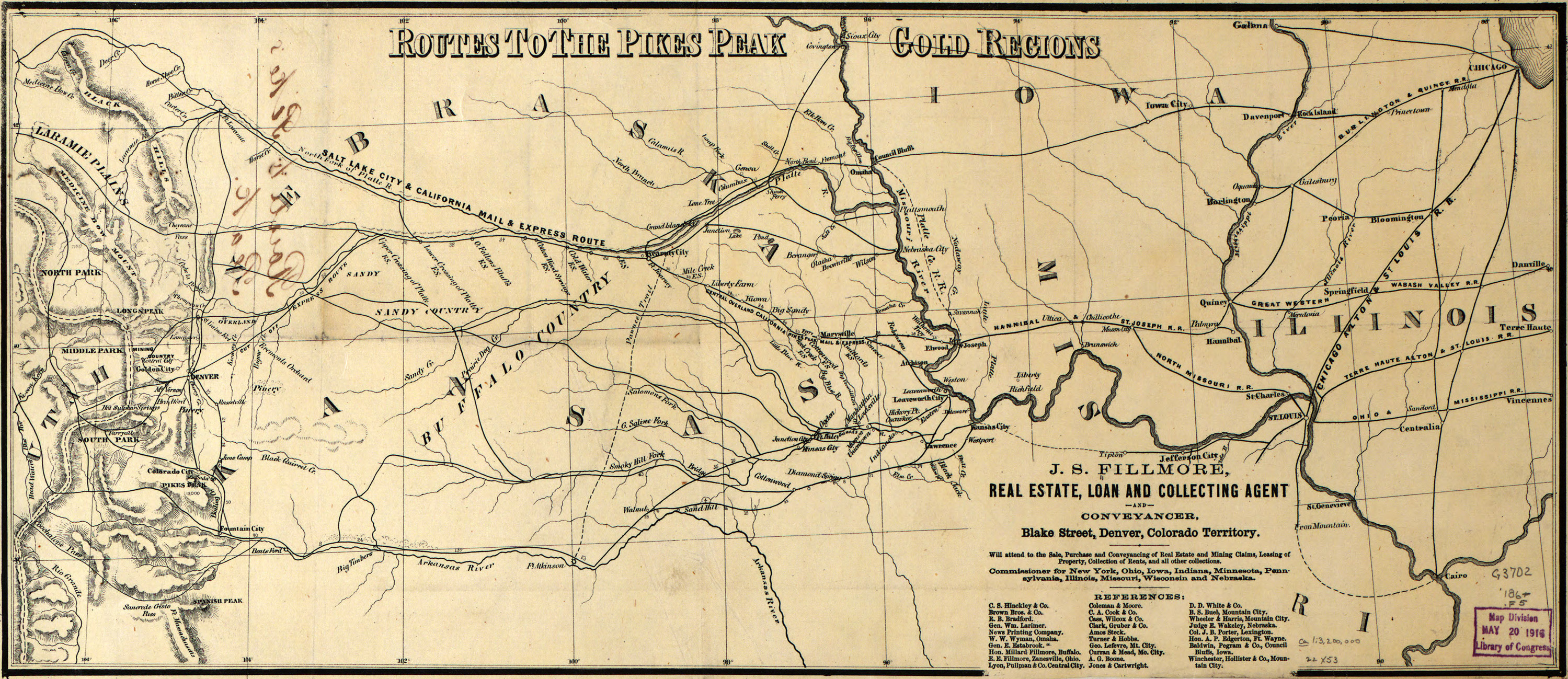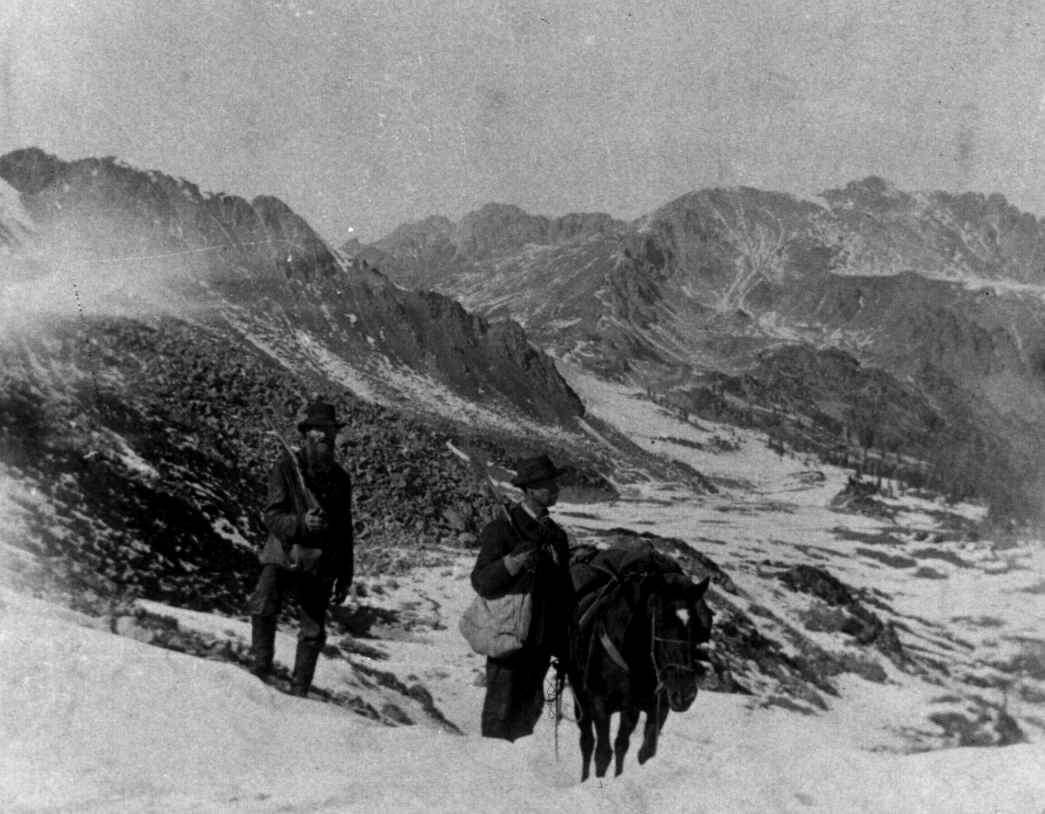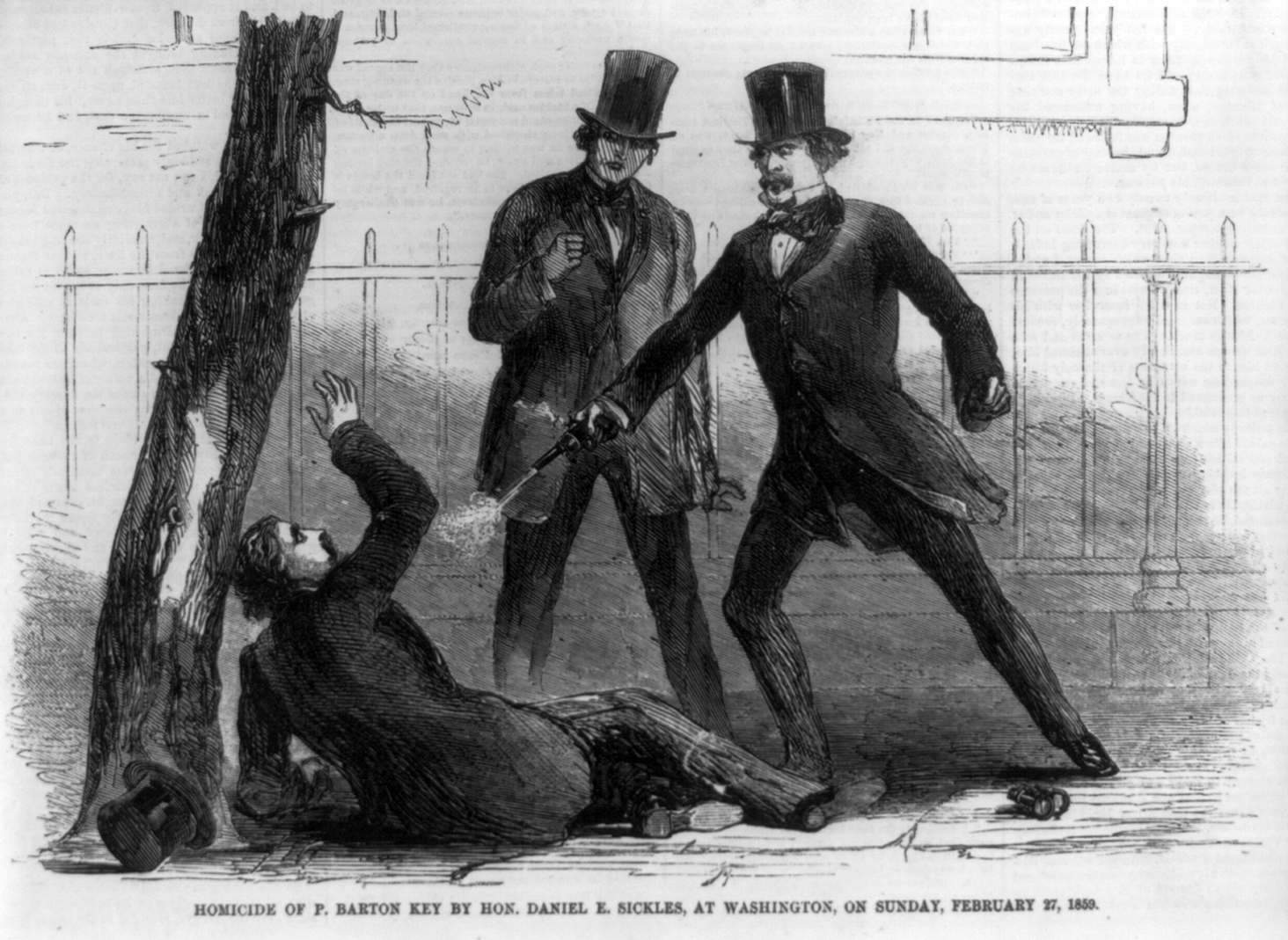|
Fifty-Niner
A "Fifty-Niner" is the term used for the gold seekers who streamed into the Pike's Peak Country of western Kansas Territory and southwestern Nebraska Territory in 1859. The discovery of placer gold deposits along the South Platte River at the foot of the Rocky Mountains in northwestern Kansas Territory by a party of miners led by William Greeneberry "Green" Russell in July 1858 precipitated the Pike's Peak Gold Rush. Many Fifty-Niners took the "Smoky Hill Trail" west through Kansas Territory up the Kansas River valley. The last significant civilian settlement along this route was Manhattan, Kansas, several hundred miles east of the mountains. Between there and the mountains the Fifty-Niners had to cross the unmarked plains, often getting lost, and sometimes confronting Plains Indians. There is no record of how many prospective miners died en route to Pikes Peak. The northern, or Platte River, route followed the Platte River through Nebraska along the Oregon Trail, then angle ... [...More Info...] [...Related Items...] OR: [Wikipedia] [Google] [Baidu] |
Pike's Peak Or Bust
The Pike's Peak Gold Rush (later known as the Colorado Gold Rush) was the boom in gold prospecting and mining in the Pike's Peak Country of western Kansas Territory and southwestern Nebraska Territory of the United States that began in July 1858 and lasted until roughly the creation of the Colorado Territory on February 28, 1861. An estimated 100,000 gold seekers took part in one of the greatest gold rushes in North American history. The participants in the gold rush were known as " Fifty-Niners" after 1859, the peak year of the rush and often used the motto Pike's Peak or Bust! In fact, the location of the Pike's Peak Gold Rush was centered north of Pike's Peak. The name Pike's Peak Gold Rush was used mainly because of how well known and important Pike's Peak was at the time. Overview The Pike's Peak Gold Rush, which followed the California Gold Rush by approximately one decade, produced a dramatic but temporary influx of migrants and immigrants into the Pike's Peak Country o ... [...More Info...] [...Related Items...] OR: [Wikipedia] [Google] [Baidu] |
Pike's Peak Gold Rush
The Pike's Peak Gold Rush (later known as the Colorado Gold Rush) was the boom in gold prospecting and mining in the Pike's Peak Country of western Kansas Territory and southwestern Nebraska Territory of the United States that began in July 1858 and lasted until roughly the creation of the Colorado Territory on February 28, 1861. An estimated 100,000 gold seekers took part in one of the greatest gold rushes in North American history. The participants in the gold rush were known as " Fifty-Niners" after 1859, the peak year of the rush and often used the motto Pike's Peak or Bust! In fact, the location of the Pike's Peak Gold Rush was centered north of Pike's Peak. The name Pike's Peak Gold Rush was used mainly because of how well known and important Pike's Peak was at the time. Overview The Pike's Peak Gold Rush, which followed the California Gold Rush by approximately one decade, produced a dramatic but temporary influx of migrants and immigrants into the Pike's Peak Country o ... [...More Info...] [...Related Items...] OR: [Wikipedia] [Google] [Baidu] |
Manhattan, Kansas
Manhattan is a city and county seat of Riley County, Kansas, United States, although the city extends into Pottawatomie County. It is located in northeastern Kansas at the junction of the Kansas River and Big Blue River. As of the 2020 census, the population of the city was 54,100. The city was founded by settlers from the New England Emigrant Aid Company as a Free-State town in the 1850s, during the Bleeding Kansas era. Nicknamed "The Little Apple" as a play on New York City's "Big Apple", Manhattan is the home of Kansas State University and has a distinct college town atmosphere. History Native American settlement Before settlement by European-Americans in the 1850s, the land around Manhattan was home to Native American tribes. From 1780 to 1830, it was home to the Kaw people, also known as the Kansa. The Kaw settlement was called Blue Earth Village (Manyinkatuhuudje), named after the river which the tribe had named the Great Blue Earth River, today known as t ... [...More Info...] [...Related Items...] OR: [Wikipedia] [Google] [Baidu] |
Buffalo Bill Cody
William Frederick Cody (February 26, 1846January 10, 1917), known as "Buffalo Bill", was an American soldier, bison hunter, and showman. He was born in Le Claire, Iowa Territory (now the U.S. state of Iowa), but he lived for several years in his father's hometown in modern-day Mississauga, Ontario, Canada, before the family returned to the Midwest and settled in the Kansas Territory. Buffalo Bill started working at the age of eleven, after his father's death, and became a rider for the Pony Express at age 15. During the American Civil War, he served the Union from 1863 to the end of the war in 1865. Later he served as a civilian scout for the U.S. Army during the Indian Wars, receiving the Medal of Honor in 1872. One of the most famous and well-known figures of the American Old West, Buffalo Bill's legend began to spread when he was only 23. Shortly thereafter he started performing in shows that displayed cowboy themes and episodes from the frontier and Indian Wars. He foun ... [...More Info...] [...Related Items...] OR: [Wikipedia] [Google] [Baidu] |
Pikes Peak
Pikes Peak is the List of mountain ranges of Colorado#Mountain ranges, highest summit of the southern Front Range of the Rocky Mountains, in North America. The Ultra-prominent peak, ultra-prominent fourteener is located in Pike National Forest, west of downtown Colorado Springs, Colorado. The town of Manitou Springs, Colorado, Manitou Springs lies at its base. The mountain is named in honor of American explorer Zebulon Pike (though he was unable to reach the summit). The summit is higher than any point in the United States east of its longitude. Name The band of Ute people who called the Pikes Peak region their home were the Tabeguache, whose name means the "People of Sun Mountain". or "sun", is the Ute language, Ute word that was given by these first people to the mountain that we now call Pikes Peak. It is thought that the Ute people first arrived in Colorado about 500 A.D., however their oral history states that they were created on Tava. In the 1800s, when the Arapa ... [...More Info...] [...Related Items...] OR: [Wikipedia] [Google] [Baidu] |
Pike's Peak Country
Pike's Peak Country was the name given to the gold mining region of the western United States near Pikes Peak during the Pike's Peak Gold Rush of 1858–1861. The Pike's Peak Country included the region of western Kansas Territory roughly west of the 104th meridian west and the region of southwestern Nebraska Territory roughly west of the 104th meridian west and south of the 41st parallel north. The Pike's Peak Country became the heart of the extralegal Jefferson Territory on October 24, 1859, and the Colorado Territory The Territory of Colorado was an organized incorporated territory of the United States that existed from February 28, 1861, until August 1, 1876, when it was admitted to the Union as the State of Colorado. The territory was organized in the w ... on February 28, 1861. Geography Pikes Peak is located at (38.840560,-105.043890). {{Colorado Former regions and territories of the United States Jefferson Territory Kansas Territory Pikes Peak ... [...More Info...] [...Related Items...] OR: [Wikipedia] [Google] [Baidu] |
Arkansas River
The Arkansas River is a major tributary of the Mississippi River. It generally flows to the east and southeast as it traverses the U.S. states of Colorado, Kansas, Oklahoma, and Arkansas. The river's source basin lies in the western United States in Colorado, specifically the Arkansas River Valley. The headwaters derive from the snowpack in the Sawatch and Mosquito mountain ranges. It flows east into the Midwest via Kansas, and finally into the South through Oklahoma and Arkansas. At , it is the sixth-longest river in the United States, the second-longest tributary in the Mississippi–Missouri system, and the 45th longest river in the world. Its origin is in the Rocky Mountains in Lake County, Colorado, near Leadville. In 1859, placer gold discovered in the Leadville area brought thousands seeking to strike it rich, but the easily recovered placer gold was quickly exhausted. The Arkansas River's mouth is at Napoleon, Arkansas, and its drainage basin covers nearly .See wat ... [...More Info...] [...Related Items...] OR: [Wikipedia] [Google] [Baidu] |
Colorado Mining Boom
Colorado (, other variants) is a state in the Mountain states, Mountain West subregion of the Western United States. It encompasses most of the Southern Rocky Mountains, as well as the northeastern portion of the Colorado Plateau and the western edge of the Great Plains. Colorado is the List of U.S. states and territories by area, eighth most extensive and List of U.S. states and territories by population, 21st most populous U.S. state. The 2020 United States Census, 2020 United States census enumerated the population of Colorado at 5,773,714, an increase of 14.80% since the 2010 United States Census, 2010 United States census. The region has been inhabited by Indigenous peoples of the Americas, Native Americans and their Paleo-Indians, ancestors for at least 13,500 years and possibly much longer. The eastern edge of the Rocky Mountains was a major migration route for early peoples who spread throughout the Americas. "''Colorado''" is the Spanish adjective meaning "ruddy", th ... [...More Info...] [...Related Items...] OR: [Wikipedia] [Google] [Baidu] |
1859 In The United States
Events from the year 1859 in the United States. Incumbents Federal Government * President: James Buchanan ( D-Pennsylvania) * Vice President: John C. Breckinridge ( D-Kentucky) * Chief Justice: Roger B. Taney (Maryland) * Speaker of the House of Representatives: James Lawrence Orr ( D-South Carolina) * Congress: 35th (until March 4), 36th (starting March 4) Events January–March * January 1 – Minting of Indian Head cent begins. * January 10 – Lucy Cobb Institute opens in Athens, Georgia. * January 28 – The city of Olympia is incorporated in the Territory of Washington. * February 14 – Oregon is admitted as the 33rd U.S. state (''see'' History of Oregon). * February 27 – U.S. Congressman Daniel Sickles shoots dead Philip Barton Key for having an affair with his wife. * March 2–3 – The Great Slave Auction, the largest single sale of slaves in U.S. history, with more than 400 people sold, takes place near Savannah, Georgia. * March ... [...More Info...] [...Related Items...] OR: [Wikipedia] [Google] [Baidu] |
California Gold Rush
The California Gold Rush (1848–1855) was a gold rush that began on January 24, 1848, when gold was found by James W. Marshall at Sutter's Mill in Coloma, California. The news of gold brought approximately 300,000 people to California from the rest of the United States and abroad. The sudden influx of gold into the money supply reinvigorated the American economy; the sudden population increase allowed California to go rapidly to statehood, in the Compromise of 1850. The Gold Rush had severe effects on Native Californians and accelerated the Native American population's decline from disease, starvation and the California genocide. The effects of the Gold Rush were substantial. Whole indigenous societies were attacked and pushed off their lands by the gold-seekers, called "forty-niners" (referring to 1849, the peak year for Gold Rush immigration). Outside of California, the first to arrive were from Oregon, the Sandwich Islands (Hawaii) and Latin America in late 1848. Of th ... [...More Info...] [...Related Items...] OR: [Wikipedia] [Google] [Baidu] |
High Plains (United States)
The High Plains are a subregion of the Great Plains, mainly in the Western United States, but also partly in the Midwest states of Nebraska, Kansas, and South Dakota, generally encompassing the western part of the Great Plains before the region reaches the Rocky Mountains. The High Plains are located in eastern Montana, southeastern Wyoming, southwestern South Dakota, western Nebraska, eastern Colorado, western Kansas, eastern New Mexico. The southern region of the Western High Plains ecology region contains the geological formation known as Llano Estacado which can be seen from a short distance or on satellite maps. From east to west, the High Plains rise in elevation from around . Name The term "Great Plains", for the region west of about the 96th or 98th meridian and east of the Rocky Mountains, was not generally used before the early 20th century. Nevin Fenneman's 1916 study, ''Physiographic Subdivision of the United States'', brought the term Great Plains into more w ... [...More Info...] [...Related Items...] OR: [Wikipedia] [Google] [Baidu] |
Landmark
A landmark is a recognizable natural or artificial feature used for navigation, a feature that stands out from its near environment and is often visible from long distances. In modern use, the term can also be applied to smaller structures or features, that have become local or national symbols. Etymology In old English the word ''landmearc'' (from ''land'' + ''mearc'' (mark)) was used to describe a boundary marker, an "object set up to mark the boundaries of a kingdom, estate, etc.". Starting from approx. 1560, this understanding of landmark was replaced by a more general one. A landmark became a "conspicuous object in a landscape". A ''landmark'' literally meant a geographic feature used by explorers and others to find their way back or through an area. For example, the Table Mountain near Cape Town, South Africa is used as the landmark to help sailors to navigate around southern tip of Africa during the Age of Exploration. Artificial structures are also sometimes built to a ... [...More Info...] [...Related Items...] OR: [Wikipedia] [Google] [Baidu] |











